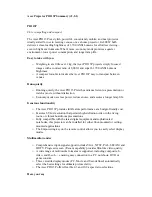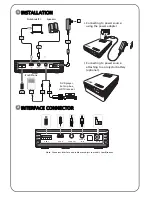
Chapter 1
Preparation — About your projector
ENGLISH - 37
r
Connecting terminals
1
5
6
7
2
4
3
11
12
10
9
8
1
<MULTI SYNC IN> terminal/<MULTI SYNC OUT> terminal
This terminal is used to connect multiple projectors when
balancing the contrast as a combined screen or synchronizing
the effects using the shutter function including the fade in/fade
out with a system using multiple projectors.
2
<SERIAL IN> terminal
This is the RS-232C compatible terminal to externally control
the projector by connecting a computer.
This terminal is also used to connect multiple projectors when
balancing the contrast as a combined screen or synchronizing
the effects using the shutter function including the fade in/fade
out with a system using multiple projectors.
3
<SERIAL OUT> terminal
This is a terminal to output the signal connected to the <SERIAL
IN> terminal.
This terminal is also used to connect multiple projectors when
balancing the contrast as a combined screen or synchronizing
the effects using the shutter function including the fade in/fade
out with a system using multiple projectors.
4
<REMOTE 2 IN> terminal
This is a terminal to remotely control the projector using the
external control circuit.
5 <REMOTE 1 IN> terminal/<REMOTE 1 OUT> terminal
These are terminals to connect the remote control for serial
control in a multiple projector environment.
6
Slot (<SLOT>)
There is an Intel
®
Smart Display Module (Intel
®
SDM)
specification slot internally. Function Board supporting the Intel
®
SDM Small (Intel
®
SDM-S) or the Intel
®
SDM Large (Intel
®
SDM-L) specification can be installed.
(
x
page 54)
7
Slot cover
8
<DC OUT> terminal
This is the USB terminal dedicated for power supply. (DC 5 V,
2 A)
Use this terminal when a power supply is required to wireless
display adapters and wireless LAN/Ethernet converters, etc.
9
<USB> terminal
This is a terminal to connect the USB memory when using the
data cloning function or firmware update function. (
x
pages
253, 259)
This is also the terminal to connect the optional Wireless
Module (Model No.: AJ-WM50 Series) when the projector is
connected via wireless LAN. (
x
page 218)
10
<HDMI IN 1> terminal/<HDMI IN 2> terminal
This is a terminal to input HDMI signal.
11 <DisplayPort IN> terminal
This is a terminal to input DisplayPort signal.
12
<LAN> terminal
This is the LAN terminal to connect to the network.
Note
f
When a LAN cable is directly connected to the projector, the network connection must be made indoors.
f
When connecting a USB memory to the <USB> terminal, also refer to “Using the USB memory” (
x
page 86).
f
When the [PROJECTOR SETUP] menu
→
[STANDBY MODE] is set to [NORMAL], power can be supplied by using the <DC OUT> terminal
even while the projector is in standby mode. If [ECO] is set, power cannot be supplied in standby mode.
















































